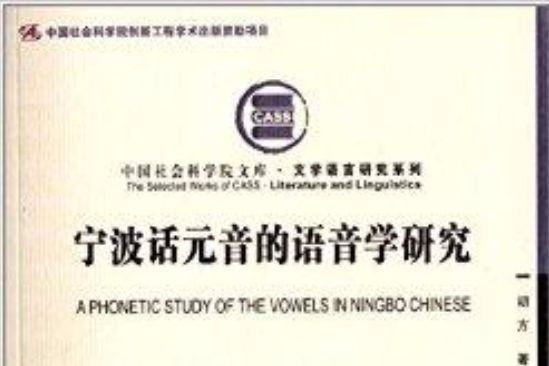內容簡介
本書使用聲學採樣、發音生理、空氣動力學實驗等科學手段對寧波方言的元音產生進行了全面的語音學分析,不僅驗證了元音產生過程中具有人類語言普遍性的舌運動機制,而且揭示了寧波方言特有的圓唇特徵,探討了漢語方言特有的舌尖元音的性質等具有理論意義的語音現象。同時,通過對發音運動的建模檢視了元音產生過程中的生理與聲學—感知之間的關係。
圖書目錄
Chapter One: Introduction
1.1 General theoretical background of vowel production
1.2 Purpose and the scope of this study
1.3 Introduction of Ningbo Chinese
1.4 Outline of the study
Chapter Two: The acoustic phonetic values of the Ningbo vowels
2.1 Introduction
2.2 Methodology
2.2.1 Test material
2.2.2 Speakers and recording
2.2.3 Data analysis
2.3 Results and discussion
2.3.1 Results and discussion of the Ningbo normal—length vowels
2.3.1.1 An overview
2.3.1.2 Vowel height
2.3.1.3 Vowel backness
2.3.1.4 Lip rounding
2.3.2 Results of the Ningbo short vowels
2.3.3 Acoustic characteristics of the Ningbo apical vowels
2.3.4 Vowel normalization and discussion on the sex difference
2.4 Conclusion
Chapter Three: An acoustic phonetic analysis of the Ningbo diphthongs and triphthong
3.1 Introduction
3.2 Methodology
3.2.1 Test material
3.2.2 Speakers and recording
3.2.3 Data analysis
3.3 Results and discussion
3.3.1 Duration results and discussion
3.3.2 Spectral results and discussion
3.3.3 Dynamic aspects
3.4 Conclusion and general discussion
Chapter Four: An articulatory analysis of the Ningbo vowels
4.1 Introduction
4.2 Methodology
4.2.1 Speakers and test material
4.2.2 Equipment
4.2.3 Procedures
4.2.4 Analysis
4.3 Results and discussion
4.3.1 Lingual configurations of the Ningbo normal—length vowels
4.3.2 A PARAFAC modeling
4.3.3 Jaw opening and its coordination with tongue movements
4.3.4 Lip rounding
4.3.5 Articulatory characteristics of the Ningbo short vowels
4.3.6 Articulation of the Ningbo apical vowels
4.4 Conclusion
Chapter Five: An artieulatory analysis of the Ningbo diphthongs and triphthong
5.1 Introduction
5.2 Methodology
5.2.1 Speakers and test material
5.2.2 Equipment and procedures
5.2.3 Analysis
5.3 Results and discussion
5.3.1 Diphthong targets and their movement
5.3.1.1 Articulation of the falling diphthongs
A.Diphthong (ai)
B.Diphthong (au)
C.Diphthong (cey)
A Summary of the articulation for the falling Diphthongs in Ningbo
5.3.1.2 Articulation of the rising diphthongs
D.Diphthong (ia)
E.Diphthong (ie?)
F.Diphthong (io)
G.Diphthong (yo?)
H.Diphthong (ua)
I.Diphthong (ua?)
J.Diphthong (ue)
A Summary of the articulation for the rising diphthongs in Ningbo
A Summary of the diphthong production in Ningbo
5.3.1.3 Articulation of the triphthong
5.3.2 Articulator kinematics of the diphthongs
5.3.2.1 Average velocity
5.3.2.2 Peak velocity and the time to peak velocity
5.4 Conclusion
Chapter Six: Acoustic, artieulatory, and aerodynamic aspects of the nasal vowels and vowel nasalization in Ningbo Chinese
6.1 Introduciton
6.2 The acoustic and articulatory studies
6.2.1 Procedures
6.2.2 Results and discussion
6.2.2.1 Spectral results
6.2.2.2 The articulatory configurations of the nasal vowels
6.2.3 Summary
6.3 The aerodynamic study
6.3.1 Methodological considerations
6.3.2 Procedures
6.3.3 Results and discussion
6.3.3.I The temporal structure of the nasal vowels and vowel nasalization
6.3.3.2 Nasality of the nasal vowels and vowel Nasalization in Ningbo
6.3.4 Summary
6.4 Conclusion
Chapter Seven: Conclusion and general discussion
7.1 Vowel features from the acoustic, articulatory,
and aerodynamic perspectives
7.1.1 Vowel height and vowel backness
7.1.2 Lip rounding
7.1.3 Nasality
7.1.4 Duration
7.1.5 Apical vowels
7.2 Articulation and acoustics of diphthongs
7.3 General discussion of the articualtory—to—acoustic relations
References
Appendix Ⅰ: Ningbo Vowel formant data
Appendix Ⅱ: Ningbo diphthong formant data
Appendix Ⅲ: Ningbo triphthong formant data
Appendix Ⅳ: The articulatory data for the Ningbo diphthongs
Appendix Ⅴ: The artieulatory data for the Ningbo triphthong
後記

